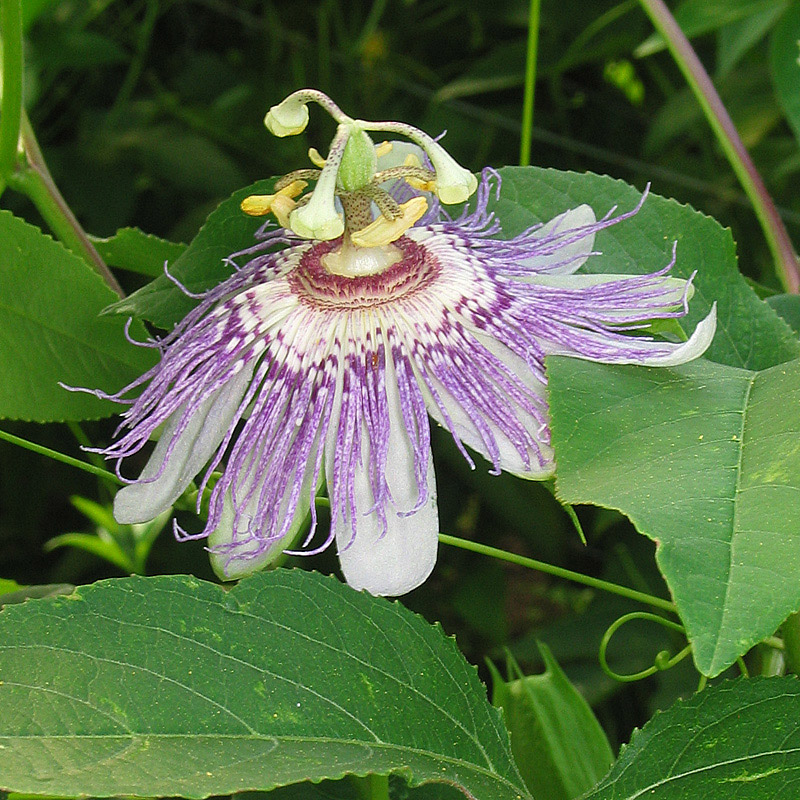Botanical name
(Flesh coloured) Passion Flower - Passiflora incarnata L.
Family
Passifloraceae
Common name
Maypop, Purple passionflower, True passionflower, Apricot vine, Wild passion flower
Information about the plant
Passion flowers are native plants of the tropical rainforest, and thus most species grow in tropical and subtropical areas of Central, North and South America. Twenty species grow in Asia, Australia, and New Zealand. Because of their unusual flowers, they were popular collectibles for botanists and collectors, who, by the 18th and 19th centuries, ensured the wide distribution of various species. Therefore, the genus Passiflora is now found in all tropical and subtropical regions. Due to the Spanish conquests, Passiflora species were introduced to Europe as ornamental plants and are now very popular there. The flesh-colored passion flower is cold-resistant and can grow outdoors and survive the winter in milder climates. The wild-growing plants in southern Europe are wild specimens of the sky blue passion flower (Passiflora caerulea L.).
The Spanish physician and botanist, Nicolás Monardes, saw in the striking flowers of P. caerulea (Blue passion flower) the symbol of the Passion of Christ, and therefore named the plant "Flos Passionis", derived from the Latin "passio" (= suffering), then translated into English, "Passion Flower". The crown-shaped, whitish-blue-stained goblet represented the crown of thorns and the color of his innocence, while the filamentous petals were the torn clothes of Jesus. The fruit, uplifted by a pedicel in the axis, the column to which Christ was bound can be recognized, and in the upper ovary, the gall-soaked sponge. The 3 stigmas represent the nails; the 5 stamens, the five wounds; and the anthers, the striking tools. The exceptionally large flowers, with a diameter of 5 to 9 cm, hang separately on the vine of a climbing plant that grows up to 10 m high. The flowering time is from May to September. The leaves are deeply lobed in three parts. Passion fruit juice (Maracuja juice) is extracted from the up to 6 cm large fruit of Passiflora edulis.
Medicinally used parts of plants (herbal drug)
The dried, crushed or cut aerial parts of the plant (passion flower herb) are used. The drug comes mainly from the leaves; flower parts and pieces may also be included. The commercially available drug comes from the USA and India.
Constituents of the herbal drug
Passion flower herb contains flavonoids, cyanogenic glycosides, free amino acids, and polysaccharides.
Quality of the drug
The quality of the following drugs or drug preparations is specified in the European Pharmacopoeia (Ph. Eur.):
- Passion flower herb (Passiflorae herba)
- Passion flower dry extract (Passiflorae herba extractum siccum)
Medical applications
Recognised medical use
The HMPC has classified passion flower herb as a traditional herbal medicinal product (see "Traditional use").
Indications supported by clinical data (marketing authorization): nervous restlessness.
ESCOP: for tension, restlessness and irritability with difficulty in falling asleep.
Traditional use
Passion flower herb was categorised by the HMPC as a traditional herbal medicine (Article 16a of Directive 2001/83/EC). Based upon long-standing use, passion flower herb is used for the relief of mild symptoms of mental stress and to aid sleep.
Herbal drug preparations in finished dosage forms
- Cut passion flower herb to prepare tea
- Dried extract in tablets, capsules, and instant teas
- Fluid extract in drops
- Passiflora incarnata as mother tincture in drops and tablets
Dosage
Finished medicinal product: see patient information leaflet.
Tea infusion: drink a cup of warm passion flower tea 2 to 4 times a day, half an hour before bedtime, to help fall asleep. Single dose of about 2 grams of the drug is useful in combination with other drugs such as valerian root, hops flowers and lemon balm leaves (sleeping and calming teas).
Preparation of a tea
Pour 150 ml of boiling water over 2 g of finely chopped passion flower and strain after 5 to 10 minutes.
Notes
It cannot be completely ruled out that passion flower herb impairs the ability to drive. No safety studies are available on the use of passion flower herb during pregnancy and lactation; its use in children under 12 years of age is not recommended due to a lack of evidence.
Side effects
At most, allergic reactions
Interactions
None known.
References
Herbal drug monographs
HMPC (2014), ESCOP (2023), WHO Vol. 3
Further literature
Commentary on the European Pharmacopoeia (Passionflower herb, No. 1459; Passionflower dry extract, No. 1882)


